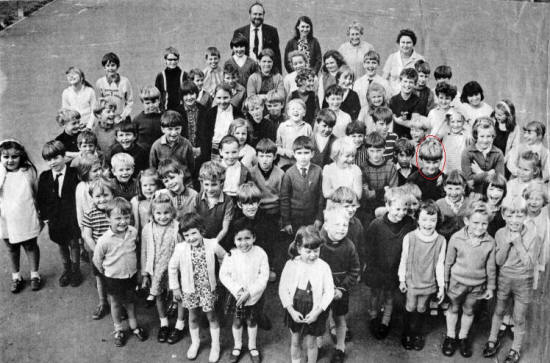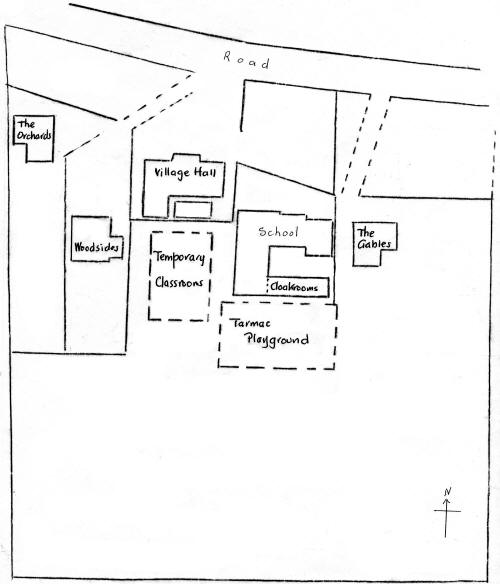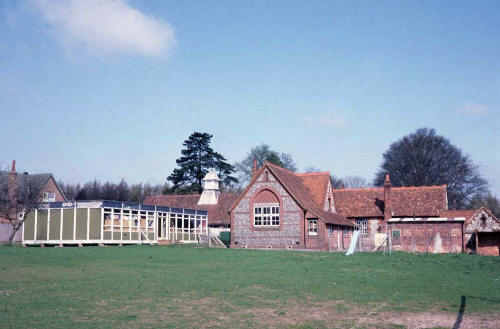Frieth School |
Mr E J Carpenter 1965 - 1985 |
|
Introduction
Preface The Early Years : 1865 - 1898 The First Headteachers The Years : 1898 - 1906 Mr & Mrs Derry : 1906 - 1930 Mrs Hinton : 1931 - 1941 Miss Browning : 1942 - 1943 Mrs Garrett : 1944 - 1952 Sep 1952 - Apr 1953 Mrs Davies : 1953 - 1960 Mr Cox : 1961 - 1965 Mr Carpenter : 1965 - 1985 Appendices Admissions register School Staff : 1865 - 1985 School Roll : 1870 - 1993 |
Mr Carpenter was educated at Windsor County Boys School (Grammar School). He
joined the Royal Artillery during World War II and rose to the rank of Captain,
serving in North Africa, Italy (throughout the Italian campaigns), Greece
(during the suppression of the ELAS) and Palestine; on the cessation of
hostilities he joined an Indian regiment in Burma.
In 1947 whilst in Burma he applied and was accepted for training as a teacher. He trained at Folkestone College (1949-50). After teaching in schools in Sandhurst, Gravesend and Bracknell (Deputy Head) he was appointed head teacher at Frieth School in September 1965. Mr & Mrs Carpenter moved into School House with their family of five children - Elizabeth, Gillian, John, Mark and Helen, and soon made many friends and became involved in Village life. For some years Mrs Carpenter ran the Wednesday club, a social facility for the over 60s and was a member of the Women's Institute, sometime holding the office of President. Mrs Carpenter became the School Secretary and together with Mrs Church was a midday supervisor. Both ladies joined in wholeheartedly with School activities and voluntarily put in many hours 'helping out' with School events. Mr Carpenter assisted the Village by serving as a member of the Village Hall and Fête committees and in many other capacities (Note 65) Above all, Mr Carpenter's contribution was in his faithfulness to the Church . He was a member of the Parochial Church Council and Church Warden for sixteen years. Click here to see a school picture from 1968 (with all the names) At school Mr Carpenter was both a good teacher and a good headmaster. Like his predecessors he believed in giving his pupils a strong foundation in the Basic Subjects. He was a true mathematician and believed that his pupils should fully understand mathematical processes, not merely use them. A standard syllabus was followed throughout the school; reading, comprehension, spelling and mathematics were taught individually. The older children were encouraged to attempt projects on topics including history, geography and science making use of the reference library that Mr Carpenter had built up (Note 66) Physical training included gymnastics using large apparatus, games and Country Dancing. Pupils took part in the Wycombe Country Dance Festivals and competed in Inter-schools Sports Days on Ibstone Common. The School Football Team were league champions in 1972. The Village Hall was hired extensively to give more room for Physical Education etc. Mr Carpenter started a Recorder group which proved very successful, the pupils playing for School Assembly and School Church services. During these years the children attended church services three times a term and participated in them: reading, acting and recorder playing. At Christmas there was either a Carol Service or Nativity Play. The school also attended Group services at Hambleden Church until transport proved a difficulty. Art work was popular and craft included pottery fired in the school's own kiln. Mr Carpenter believed in testing work throughout the school. During the first years he devised his own tests to supplement the Schonell tests, and later he introduced the Richmond tests. Full records were kept and parents informed of their children's progress by half-yearly reports and at Open Evenings. During each year a number of school visits were enjoyed, to zoos, museums and places of interest. Several times Mr Carpenter organised his "Round Bucks Tour" so that the children could get to know and appreciate other parts of their own county. School teams entered for the Wycombe Rural District's Road Safety Quizzes and pupils were encouraged to take Cycle Proficiency Tests. Regular visits by the Police stressed Road and Child safety. There were regular visits by the Health Visitor who gave the children lessons on hygiene and in the later years the older children were also given sex education. 
Mr Carpenter (centre top), Sue Priddy (nee Labram), Mrs Ann Carpenter, Joan Barksfield and the whole school. October 1970 [ Thanks to Mark Carpenter for correcting the names. Chuck Smeeton writes: I remember your mum as I was a student (known as Charles rather than Chuck in those days!) at the school from 1970-1972 when my dad (Jon Smeeton) was transferred to the UK for work - I'd guess I may have been the only Aussie to have been there. We lived in Tedders for one year and in Dormer Cottage the next and I have happy memories of football games in the school playground. I'm in the photo [ circled in red ]. These days I live in Sydney but often think of that period of my life. Once again, great work and thanks for the memories!! ] Each year the May Day ceremony took place (renamed the Summer Queen Ceremony) - the children having elected their Queen - Mr Carpenter extended the song, music, drama and country and maypole dancing so that all the children could be involved. The annual Bucks School Camp on the Isle of Wight was one extra-curricular activity to which Mr Carpenter took parties of children each summer holiday until 1974. Mr Carpenter was a chess player and taught his pupils how to play well. The School entered teams for the Wycombe Schools chess championships and were WPS Chess Association Champions in 1972 and 1983. Individuals were selected to play for the Wycombe team that took part in the National Team Championships at venues across Britain. Peter Grant (1972) and Timothy Rogers (1986) became Wycombe Primary Schools Individual Chess Champions. Mr Carpenter undertook other responsibilities in the larger world of Education: he was for 10 years Secretary of the Wycombe Headteachers Association and sometime its President and President of the Bucks Federation of Headteachers. He was also chairman of the Wycombe Schools Country Dance Festival, of the Marlow Schools Music Festival and the chairman for fourteen years of the Wycombe Primary Schools Chess Association. During these years some significant changes took place which necessitated reorganisation and building. Between 1969 and 1974 the Divisional Education Officer formulated a plan to make Frieth the Combined Valley School (ages 5 to 12 years) with Hambleden and Turville becoming First Schools ( ages 5 to 8 years) . Objections, opposition and public enquiries followed; other sites for the Combined School were suggested at Skirmett and Hambleden but these were rejected because of local opposition. Finally economic recession set in and the money allocated to modernise Victorian built schools was no longer available. (Note 67) For some years the Bucks Education Committee had been trying to buy the allotments adjoining the rear of Frieth School in order to provide playing area for the children. After the death of the owner, Mr Wood, who lived at The Gables his wife moved and sold the whole property to the Bucks Education Committee. Now Frieth School had enough land to expand.
In 1973 the Bucks Education Committee decided that an extra educational year should be retained in the Primary and Junior Schools so Frieth became a Combined School retaining pupils in their 12+ year (Note 68) The qualifying examination for selecting children for Secondary Education was also raised to 12+ (Note 69) By 1972 the School Roll had risen from 47 in 1965 to 96. The Education Authority provided a large temporary building consisting of two classrooms with a space between them for use as a cloakroom but with no lavatory facilities (Note 70) However after Mr Carpenter had made representations through the Managers to the LEA two 'Portaloos' were provided. Under the reorganisation the staff was increased to four teachers. By employing two part-time teachers Mr Carpenter was able to reorganise the classes so that there were four teaching groups for the essential morning work and take out the 12+ children for extra Maths lessons and French. When the two temporary classrooms came into use the middle classroom was divided by a screen of furniture to form an office, storage space for stock and an area for staff use.
By 1983 when School Rolls all over the country were falling (Note 71) the DEO's plan for reorganising the Valley Schools of Hambleden, Turville and Frieth was resurrected, but still no agreement could be reached in the Hambleden Parish. However, against strong opposition Turville School was finally closed and its catchment area added to Frieth with the facility of free bus transport. Some pupils and one teacher were transferred to Frieth School. In 1966 the west wall of the middle classroom was in danger of collapsing and had to be rebuilt. The top class had to use the Village Hall until the rebuilding had been completed. (Note 72) In 1976 the acquired allotment area was grass sown and finally usable as a playing field in 1977. In 1980 an area of the new ground was surfaced with tarmac to form a playground on the school premises (See Plan 8) In 1984 new thermostatically controlled oil stoves were installed to replace the old Coleman stoves. In 1985 a new suspended ceiling was fitted in the Infant room and the Parents Association, frustrated by lack of will to replace the Victorian toilet block, were given permission to rebuild the screening walls and reroof the block with transparent sheeting (Note 73) With the temporary classrooms fast coming to the end of their life the managers agreed for plans to be made to modernise the school. Mr Carpenter made a draft plan which was accepted and a design based on this drawn up. The work was to be done in two phases. Phase I - The erection of a new toilet and cloakroom block (Note 74) Phase II - The addition of two classrooms to replace the temporary block and the addition of an office, staffroom, library/utility area and enlargement of the hall (Note 75) During the years as head, Mr Carpenter acquired many items of equipment, some through the generosity of the Parents' Association, in order to widen the children's experiences. Some of these were :
He did not ignore modern developments and modernised the school reading scheme and by the time he retired had commenced to update the mathematics scheme. Mr Carpenter and his staff, including Mrs Church, regularly attended educational courses at Missenden Abbey. He welcomed students from Easthampstead Teachers Training College for their teaching practice and, in later years, girls from the High School for "work experience". From time to time the older children took part in Village Entertainments e.g. A Bartholomew Fair in Hambleden Church; Frieth Village Concerts; Wednesday Club; Art & Craft display at Hambleden Church Flower Festival. All children used the computer to supplement various educational skills. For instance the top class built up a large scale database on animals - their lifestyle etc, having done their own research. In 1985 the older children took part in the BBC's Domesday Project which required extensive research into the local area historically, socially and geographically. The results were committed to the computer and submitted to the BBC to form part of a database covering the whole country. For the first fifteen of these years I enjoyed the post of Infant Teacher working for Mr Carpenter. I found him an excellent organiser and a most supportive headmaster. Most of the time the school was organised as three classes, the 7-9 year olds being taken mostly by young and inexperienced teachers so that Mr Carpenter had to give them a considerable amount of help and advice as well as being a class teacher and running the school (Note76) Mr Carpenter took early retirement in 1985 (Note 77) but he and his wife (Note 78) did not have to leave the village as the Parochial Church Council (Note 79) no longer required the School House for a headteacher. However Mr Carpenter's retirement was the end of an era when the Headteacher, living and working in the village, not only ran the school but was involved in the societies, activities and functions of the village in general. Long ago were the days of his early predecessors, like Mr West, who were expected to undertake all manner of duties outside the School hours, but which succeeding heads had performed voluntarily. Notes Comments in [ square brackets ] are mine or contributed by others, the rest is my mother's original text. (65) If at all possible Mr Carpenter and I made a point of one or other of us being represented in almost every activity that took place in the Village (66) Later when children of 12+ were retained in the school, French lessons were added to the curriculum (67) Medmenham School was closed in 1974 but the children were transferred to Danesfield School - the Hambleden Valley Church Group had not been constituted at that time (68) This change coincided with the raising of the school leaving age to 16 which would have necessitated much further building (and expense) in the Secondary Sector. Also many small Primary Schools cold see the advantage of extra pupils. In the writer's opinion the change to transfer a 12+ was undertaken more on economic and expedient grounds than on educational ones. Mr carpenter agreed with this assessment though he felt that retaining the 12 year olds did have some advantage for the majority of pupils. (69) Since the sixties Frieth School pupils have been successful in obtaining selective school places and many have gone on to Higher Education and University (70) This was not a new building; it had already served for fifteen years at a school in the Aylesbury district (71) There was a countrywide drop in the birthrate (72) One evening after the children had gone home Mr Carpenter noticed that the mobiles hanging from the stress bar (an iron bar inserted between the wall of the all and the west wall) were waving about. He and I kept an eye on this phenomenon and noticed that whenever a person walked across the room the mobiles oscillated in an alarming fashion. Also the stress bar had moved out from the wall as shown by the absence of paint on that portion of it. (73) With hindsight this well meaning project merely "put off the evil hour" when the Diocese of Oxford would have to replace the whole structure. (74) The cloakroom block was eventually built in 1985 and brought into use in 1986 (See Plan 8) (75) After several revisions of plans Phase II was completed in 1993 (76) Perhaps the worst disadvantage of being Head of a small school (77) A retirement party was held to which the managers, ex staff who had served with Mr Carpenter, and ex pupils over school leaving age were invited. A very happy re-union for all who attended (78) Their children are all married now (1993). Elizabeth, Gillian and their families have emigrated to Australia. After successful careers in the army John (REME) is an Aero-engineer and Mark (RA) a constable in the Metropolitan Police and Helen is a hairdresser living in High Wycombe (79) c1966 Lord Hambleden sold the School House to the Parochial Church Council |


